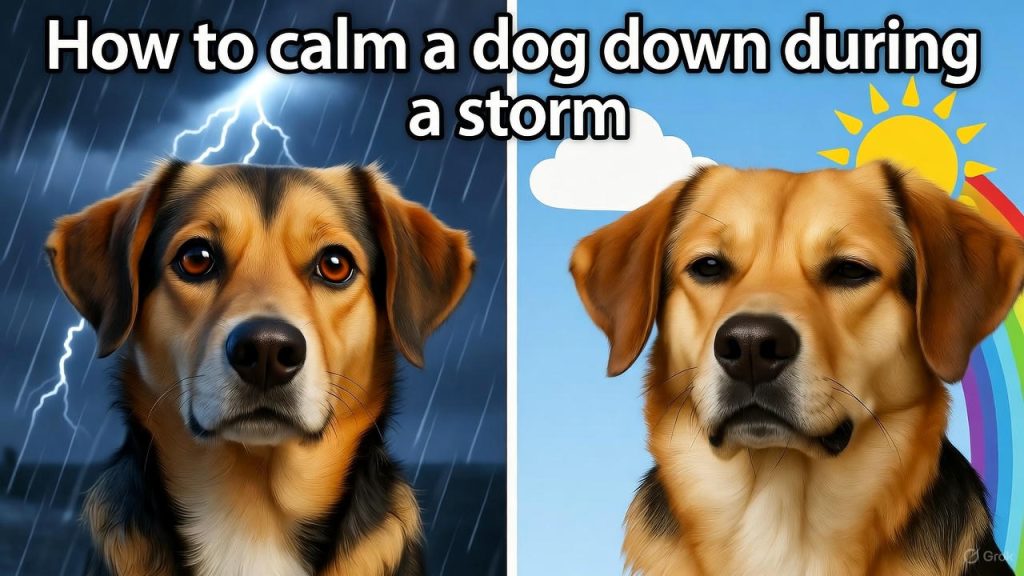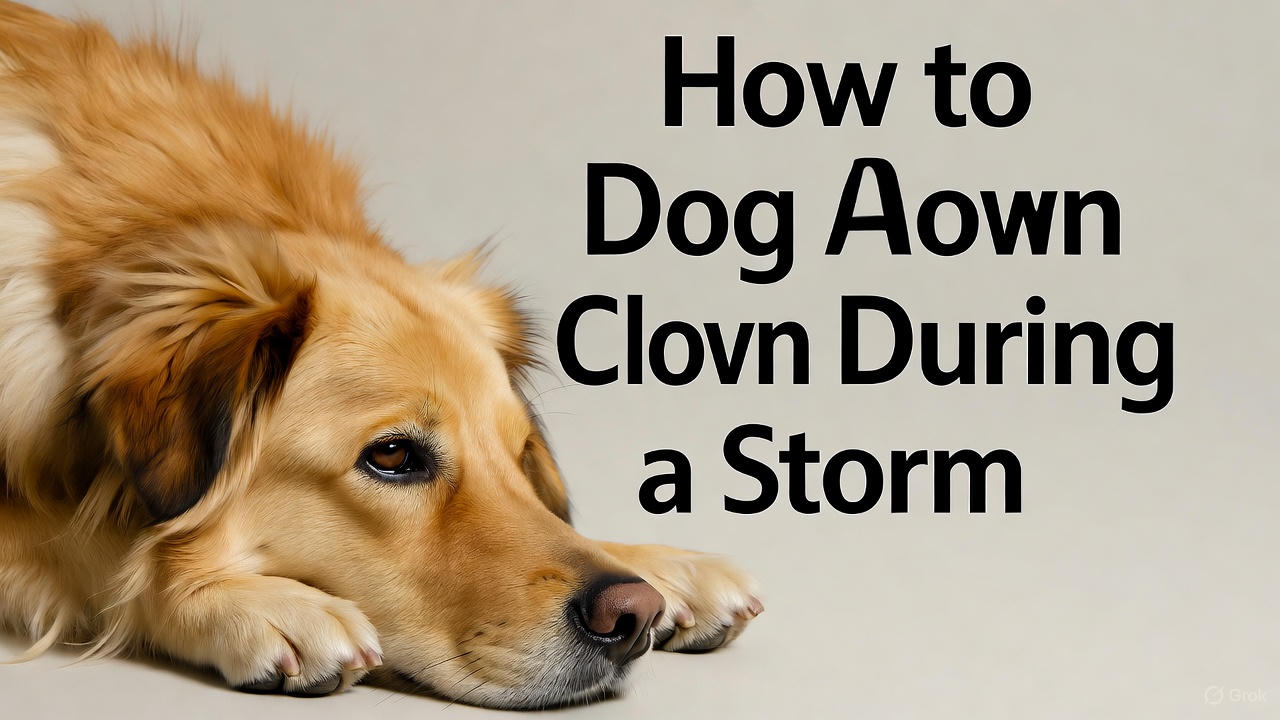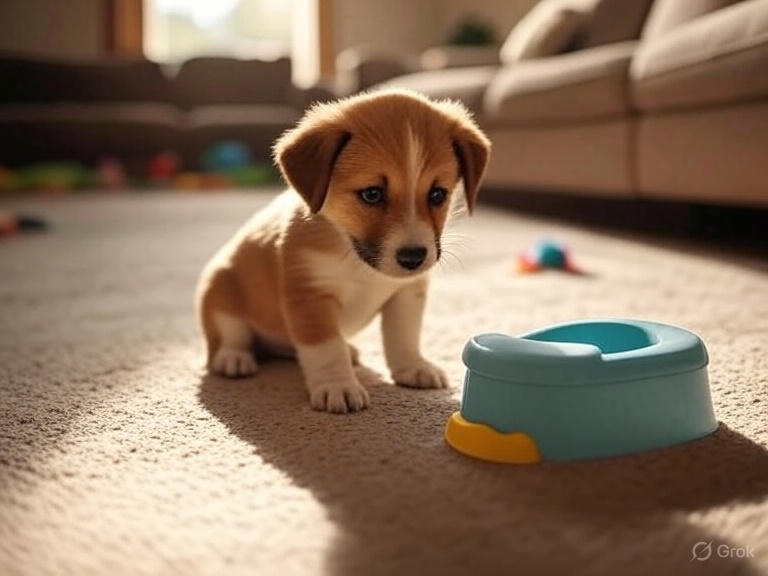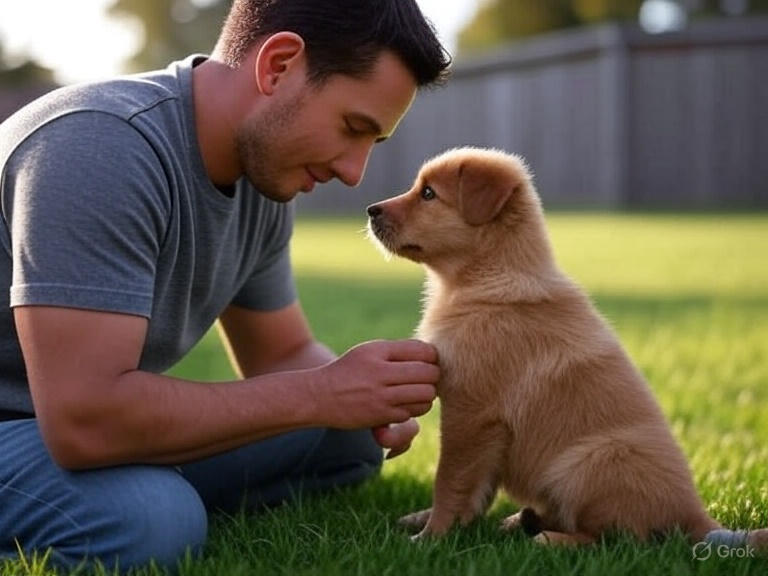How to Calm a Dog Down During a Storm?
Thunder crashes outside. Lightning flashes across the sky. Your beloved dog starts panting heavily, pacing around the house, or hiding under the bed. Storm anxiety in dogs is heartbreaking to watch, but you’re not powerless to help.
Millions of dog owners face this challenge every time dark clouds roll in. The good news? You can take real steps to ease your furry friend’s fear and help them feel safe when bad weather strikes.
Why Dogs Fear Thunderstorms
Dogs experience storms differently than we do. Their hearing is roughly four times more sensitive than human hearing. This means thunder sounds much louder and more frightening to them. The rumbling that seems distant to us feels like it’s happening right next to them.
Beyond the noise, dogs can detect changes in barometric pressure before a storm arrives. They feel static electricity building in the air. Some experts believe the static shocks they might receive from their fur make them even more anxious. Your dog might start acting nervous before you even notice clouds forming.
Past traumatic experiences also play a role. A dog that was caught outside during a severe storm might develop lasting anxiety. Even dogs with no bad memories can develop storm phobia over time. The fear often gets worse with age as hearing becomes more acute.
Signs Your Dog Is Scared of Storms
Recognizing anxiety symptoms helps you respond quickly. Dogs show fear in various ways. Some signs are obvious while others are subtle.
Panting heavily is one of the most common reactions. Your dog might drool excessively or pace back and forth without settling down. Many dogs try to hide in closets, under beds, or in bathrooms. They’re looking for a safe den-like space.
Shaking and trembling happen frequently during storms. Your dog might press against you or follow you everywhere. Some dogs become destructive, scratching at doors or chewing furniture. They’re trying to escape the scary sounds.
Whining, barking, or howling are vocal signs of distress. You might notice dilated pupils or wide eyes. Some dogs refuse to eat their favorite treats. Others have accidents in the house even though they’re house-trained.
Physical symptoms can include increased heart rate and excessive shedding. Watch for yawning (which signals stress in dogs), lip licking, or pinned-back ears. These body language cues tell you your dog needs help.
Create a Safe Space Before the Storm
Preparation makes a huge difference. Setting up a comfortable retreat gives your dog somewhere to go when they feel scared.
Find the quietest room in your house. Interior bathrooms work well because they have fewer windows and the sound is muffled. Basements are excellent choices if you have one. The underground location blocks much of the storm noise.
Set up a cozy den in this space. Use a crate if your dog likes their crate. Many dogs find crates comforting because they mimic natural dens. Leave the door open so your dog never feels trapped. If your dog doesn’t use a crate, create a nest with blankets and pillows.
Add items that smell like you. An old t-shirt or blanket you’ve used works perfectly. Your scent provides comfort and security. Include your dog’s favorite toys and a water bowl.
Block out as much noise as possible. Heavy curtains on windows help. You can play calming music or turn on a white noise machine. These sounds mask the thunder and create a peaceful atmosphere.
Make this space available well before storm season starts. Let your dog explore it on calm days. Feed treats there. Play games nearby. You want your dog to associate this area with positive experiences, not just storms.
Stay Calm Yourself
Dogs are incredibly perceptive. They pick up on your emotions and energy. If you act nervous about the approaching storm, your dog will sense that something is wrong.
Keep your behavior as normal as possible. Don’t make a big fuss when thunder starts. Speak in your regular voice. Go about your usual activities. This shows your dog that everything is fine and there’s no real danger.
That said, don’t ignore your frightened dog completely. You can provide comfort without reinforcing fear. The old myth that comforting a scared dog rewards the fear has been debunked by veterinary behaviorists. You can’t reinforce an emotion. Comforting your dog is actually helpful.
Act confident and relaxed. Pet your dog if they come to you. Use a calm, soothing voice. Just don’t be overly sympathetic or anxious in your tone. Think of yourself as the steady anchor in the storm.
Use Pressure Therapy
Many dogs respond well to gentle, constant pressure. This technique works similarly to swaddling a baby. The pressure releases calming hormones and makes dogs feel secure.
Thunder shirts and anxiety wraps are designed for this purpose. These snug-fitting garments apply gentle pressure to your dog’s torso. Studies show they help reduce anxiety in many dogs during storms. Put the wrap on before the storm starts for best results.
You can also create gentle pressure yourself. Sit with your dog and place your hand firmly but gently on their body. Some dogs like pressure on their chest. Others prefer it on their sides or back. Watch your dog’s body language to see what helps.
A weighted blanket made for dogs provides continuous pressure therapy. Make sure it’s the right weight for your dog’s size. The blanket should never restrict breathing or movement.
Try Distraction Techniques
Redirecting your dog’s attention can work wonders. This is especially effective if you catch the anxiety early before it escalates.
Engage your dog in their favorite activities. Start a game of tug-of-war. Practice training commands with high-value treats. Work on tricks they enjoy. Mental stimulation helps take their mind off the storm.
Puzzle toys filled with treats keep dogs occupied. Frozen Kong toys stuffed with peanut butter or wet food take time to finish. Snuffle mats let dogs use their natural foraging instincts. These activities provide a positive focus during scary weather.
The key is starting before your dog becomes too anxious. Once fear takes over completely, distraction becomes much harder. Watch the weather forecast and have activities ready.
Massage and Touch Therapy
Gentle massage calms the canine nervous system. The right touch can lower heart rate and reduce stress hormones.
Start with slow, gentle strokes along your dog’s body. Use firm but soft pressure. Avoid quick or jerky movements. Focus on areas where your dog holds tension. Many dogs carry stress in their shoulders, neck, and back.
Try ear massage specifically. Dog ears contain many nerve endings. Gently rubbing the ear flaps in circular motions can trigger relaxation. Start at the base of the ear and work toward the tip. Keep your movements slow and rhythmic.
Acupressure points can also help. The spot between your dog’s eyes, just above the nose, can promote calmness when massaged gently. The area behind the ears at the base of the skull is another calming point.
Watch your dog’s response. Some dogs love being touched during stressful times. Others prefer space. Never force contact if your dog moves away.
Block Sensory Input
Reducing what your dog sees and hears makes storms less overwhelming.
Close all curtains and blinds before the storm arrives. Lightning flashes through windows can startle dogs badly. Darkening the room helps. Some dogs do better with a nightlight so they’re not in complete darkness.
Turn on background noise to mask thunder. Television works well, especially with volume slightly higher than normal. Fans create white noise. Some people use rainfall or ocean sounds. Classical music specifically composed for dogs is available and can be very effective.
You can find playlists designed to calm anxious dogs on music streaming services. Studies show that certain frequencies and tempos reduce canine stress. Play these during storms and during calm times so your dog doesn’t associate the music only with bad weather.
Close windows and doors to muffle outdoor sounds. Run the air conditioner or heater fan if appropriate. These constant background sounds help drown out unpredictable thunder crashes.

Consider Calming Supplements
Natural supplements help take the edge off storm anxiety for many dogs. These aren’t sedatives. They work with your dog’s body chemistry to promote relaxation.
Products containing L-theanine, an amino acid found in green tea, show promising results. This compound promotes relaxation without drowsiness. It’s safe for long-term use and can be given daily during storm season.
CBD oil for pets has become popular for anxiety management. Research on its effectiveness is still ongoing, but many owners report positive results. Always choose products specifically formulated for dogs. Check with your veterinarian about proper dosing.
Melatonin supplements can help some anxious dogs. This natural hormone regulates sleep cycles and has calming properties. Proper dosage depends on your dog’s weight. Never use melatonin products containing xylitol, which is toxic to dogs.
Calming chews with chamomile, valerian root, or passion flower are widely available. These herbs have mild sedative effects. Give them about 30 minutes before the storm is expected to arrive.
Always talk to your veterinarian before starting any supplement. They can recommend appropriate products and dosages for your dog’s specific needs.
Work on Desensitization Training
Long-term desensitization can reduce storm phobia over time. This process takes patience but delivers lasting results.
The technique involves exposing your dog to storm sounds at very low volumes. You can find thunderstorm recordings online. Start playing these sounds so quietly your dog barely notices. Give treats and praise while the sounds play.
Gradually increase the volume over many sessions. This might take weeks or months. Go at your dog’s pace. If they show anxiety, you’ve increased the volume too quickly. Go back to a level where they’re comfortable.
Pair the sounds with extremely positive experiences. Feed meals while storm sounds play quietly. Give the best treats during practice sessions. Play favorite games. You want your dog to build positive associations with these sounds.
This training works best between storm seasons when your dog isn’t already on high alert. Consistency is critical. Short daily sessions work better than occasional long ones.
Some dogs benefit from working with a professional dog trainer or veterinary behaviorist. They can create a customized desensitization program for severe phobia cases.
Anti-Anxiety Medications
For dogs with severe storm phobia, medication might be necessary. This is nothing to feel guilty about. Some dogs need pharmaceutical help to cope.
Fast-acting anti-anxiety medications can be given before storms. These must be prescribed by your veterinarian. Common options include trazodone and alprazolam. They work quickly to reduce panic and fear.
Timing matters with these medications. You need to give them before the storm starts or at the very first signs of anxiety. Once your dog is in full panic mode, medications are less effective.
Some dogs benefit from daily anxiety medication during storm season. These maintenance medications build up in the system and provide ongoing support. Fluoxetine (Prozac) and clomipramine are examples of daily medications used for anxiety disorders in dogs.
Your vet might recommend a combination approach. A daily medication provides baseline calm, while a fast-acting medication helps during actual storms.
Never use medication without veterinary guidance. Proper dosing is essential for safety and effectiveness. Your vet will consider your dog’s health history, weight, and other medications when prescribing.
Don’t Punish Fear Responses
Your dog isn’t misbehaving during storms. They’re genuinely terrified. Punishment makes everything worse.
If your dog has an accident in the house, clean it up without scolding. If they scratch at doors or damage items while panicking, this isn’t defiance. It’s desperate fear-driven behavior.
Yelling at or punishing a frightened dog increases their stress. They might start associating you with the scary storm. This damages your bond and makes them feel even less safe.
Instead, focus on prevention and management. Use the techniques described here to reduce anxiety before it leads to destructive behavior. If damage occurs, consider it a sign that your current approach needs adjustment.
Special Considerations for Different Life Stages
Puppies experiencing their first storm season need extra care. Early positive experiences prevent lifelong phobia. Stay upbeat during storms. Play games and act like nothing is wrong. Don’t coddle too much, but don’t ignore a frightened puppy either.
Senior dogs often develop worsening storm anxiety. Age-related hearing loss might make them more sensitive to pressure changes and vibrations. Cognitive decline can increase general anxiety. Be extra patient with older dogs. They might need more medication support than they did when younger.
Rescue dogs with unknown histories might have severe storm reactions. They could have trauma you’re unaware of. These dogs often need professional behavioral help combined with medication.
When to Seek Professional Help
Some cases require expert intervention. If your dog’s storm anxiety is severe and nothing you try helps, consult a veterinary behaviorist. These specialists have advanced training in animal behavior and psychology.
Signs you need professional help include self-harm behavior during storms. Some dogs injure themselves trying to escape or hide. If your dog completely shuts down and won’t respond to anything, professional guidance helps.
Extreme destruction or aggression during storms needs expert attention. When fear interferes with your dog’s quality of life or your household safety, specialized help is warranted.
Your regular veterinarian can make referrals to behavioral specialists. They can also rule out medical issues that might be contributing to anxiety.
Building Long-Term Confidence
Beyond storm-specific strategies, building your dog’s overall confidence helps. A generally confident dog handles stress better.
Regular training sessions strengthen your bond and give your dog confidence. Learning new skills and receiving praise builds self-assurance. Even simple obedience work makes a difference.
Regular exercise is crucial. A physically tired dog has less energy for anxiety. Mental enrichment through puzzle toys, sniffing games, and exploration also helps. Dogs with rich, fulfilling lives tend to be more resilient.
Maintain consistent routines. Dogs thrive on predictability. When most of their life is stable and reliable, they cope better with unpredictable events like storms.
Positive socialization experiences help dogs become more adaptable. Safe interactions with other dogs, people, and environments build emotional resilience.
The Bottom Line
Storm anxiety in dogs is common but manageable. You have many tools available to help your furry friend feel safer during bad weather.
Start with creating a safe space and staying calm yourself. Try pressure therapy with a thunder shirt. Use distraction and massage techniques. Block sensory input when possible. Consider natural supplements or medications if needed.
Long-term desensitization training offers lasting improvement. Be patient with your dog and yourself. Finding the right combination of techniques takes time.
Every dog is different. What works perfectly for one might not help another. Stay observant and adjust your approach based on your dog’s responses.
With consistent effort and the right strategies, most dogs can learn to cope better with storms. Your anxious pup can get through storm season with your support and love. The key is starting preparation now, before the next thunderstorm rolls in.







